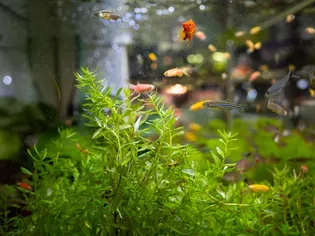Lighting Requirements for Plants in Community Aquariums
Updated on 04/26/24

Illuminating the Underwater Realm: Lighting Requirements for Plants in Community Aquariums
In the vibrant tapestry of community aquariums, plants play a crucial role as photosynthetic lifeforms that provide oxygen, absorb nutrients, and create a captivating natural aesthetic. However, to thrive and fulfill their ecological functions, aquarium plants require specific lighting conditions that mimic their natural habitats. This comprehensive guide will delve into the intricate world of plant lighting, empowering you to create an optimal underwater environment that fosters plant growth and enhances the overall beauty of your community aquarium.
Understanding the Photosynthesis Process
The foundation of plant lighting lies in understanding the process of photosynthesis, the remarkable biological mechanism that converts light energy into chemical energy. Through this process, plants utilize chlorophyll, a green pigment, to absorb light primarily in the blue and red spectrums. This absorbed light energy is then used to convert carbon dioxide and water into glucose, a sugar that serves as the primary food source for the plant.
Essential Lighting Factors for Aquarium Plants
To ensure optimal plant growth and health, several key lighting factors must be considered:
- Light Intensity: Measured in lumens per liter (lm/L), light intensity determines the amount of light available for photosynthesis. Low light levels (less than 15 lm/L) can inhibit plant growth and result in leggy, weak stems, while excessive light levels (over 50 lm/L) can scorch plant leaves and lead to stunted growth.
- Light Duration: The duration of daily light exposure is crucial for plant development. Most aquarium plants require a minimum of 8-12 hours of light per day, while some species may need longer durations (up to 16 hours).
- Light Spectrum: Plants absorb light primarily in the blue (400-495 nm) and red (620-700 nm) spectrums. Blue light promotes the production of chlorophyll, essential for photosynthesis, while red light is vital for stem growth and red coloration in certain plant species.
Types of Aquarium Lighting
Aquarium lighting systems come in various types, each with its unique advantages and drawbacks:
- Fluorescent Lighting: Fluorescent bulbs, popular for their energy efficiency and affordability, emit light in a broad spectrum, including both blue and red wavelengths. However, their light output can be uneven, and they require frequent replacement (every 6-12 months).
- Compact Fluorescent Lighting (CFL): CFLs are more compact and efficient than traditional fluorescent bulbs, with a longer lifespan (up to 10,000 hours). They provide a more concentrated light beam, allowing for better penetration in deeper aquariums.
- Light-Emitting Diode (LED) Lighting: LEDs have revolutionized aquarium lighting with their energy efficiency, long lifespan (up to 50,000 hours), and tunable light spectrums. They can be customized to deliver specific wavelengths for optimal plant growth and aesthetic appeal.
Practical Lighting Examples for Community Aquariums
To illustrate the principles discussed, let's explore specific lighting examples for different types of community aquariums:
- Low-Light Aquariums (10-15 lm/L): Ideal for beginner aquarists or aquariums with low-maintenance, low-light-requiring plants such as Java ferns, Anubias, and Cryptocoryne. Fluorescent bulbs or LED lights with a warm white spectrum (2700-3000 Kelvin) are suitable choices.
- Medium-Light Aquariums (20-30 lm/L): Suitable for a wider range of plants, including Amazon swords, Hornwort, and Vallisneria. Compact fluorescent bulbs or LED lights with a combination of blue and red wavelengths (6500-7500 Kelvin) provide optimal growth conditions.
- High-Light Aquariums (over 30 lm/L): Designed for demanding plants such as Rotala, Hygrophila, and Ludwigia, which require intense light for vibrant coloration and lush growth. LED lights with customizable spectrums, allowing for fine-tuning of light intensity and wavelength, are the preferred choice for these aquariums.
Conclusion
Understanding and providing the appropriate lighting conditions for plants in community aquariums is a crucial aspect of successful aquarium keeping. By grasping the principles of photosynthesis, considering essential lighting factors, and selecting the right lighting system, you can create an underwater environment that fosters plant growth, enhances their aesthetic appeal, and ultimately enriches the overall beauty and ecological balance of your aquarium.
Explore More Pets

Freshwater Aquarium Filters
How to Deal With Cloudy Aquarium Water

Saltwater Aquarium Filters
How Do You Remove Chloramines From Tap Water?

Freshwater Aquariums & Habitat
Can I Keep My Koi Fish Inside?

Saltwater Aquariums & Habitat
14 Best Floating Plants for Your Aquarium

Freshwater Fish Health
How to Treat Ich on Freshwater Fish

Saltwater Fish Health
Fin Rot in Aquarium Fish

Freshwater Aquarium Filters
How to Do Aquarium Water Changes

Saltwater Fish Health
How Do Fish Get Parasites?